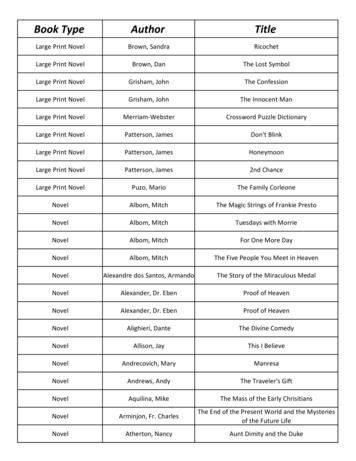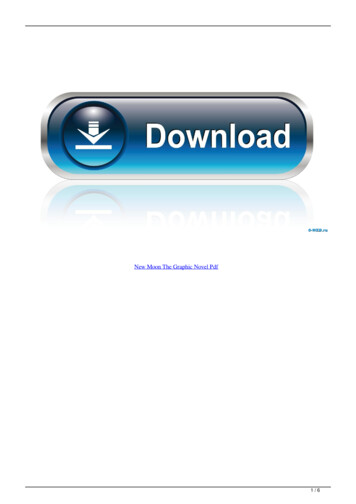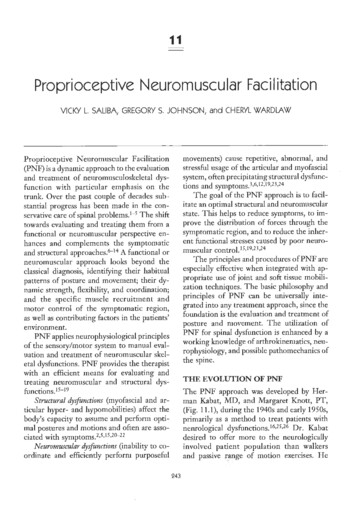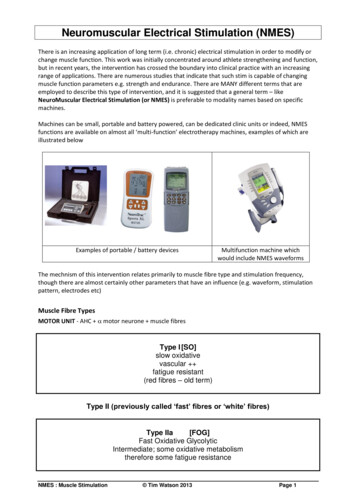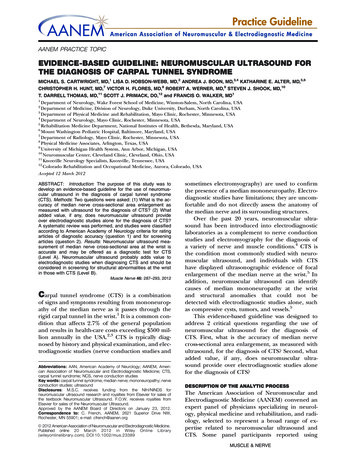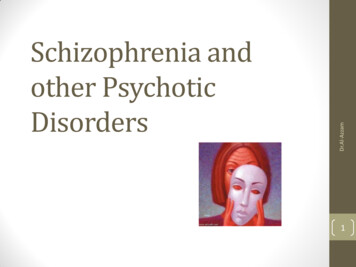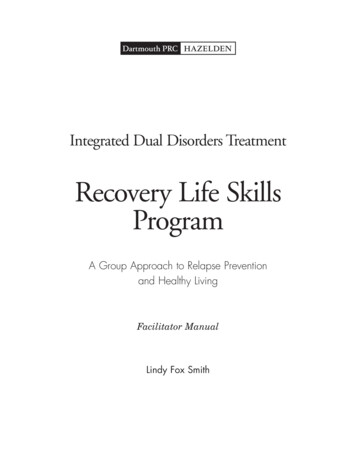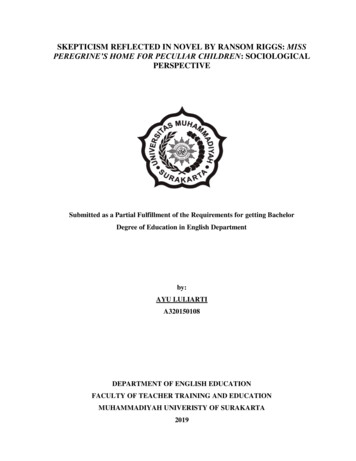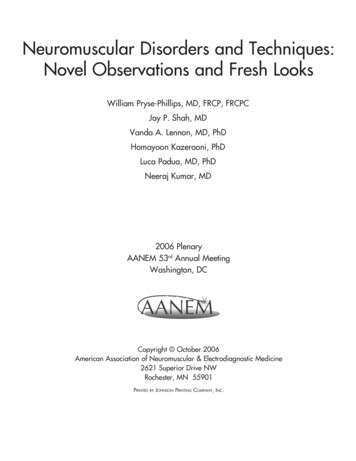
Transcription
Neuromuscular Disorders and Techniques:Novel Observations and Fresh LooksWilliam Pryse-Phillips, MD, FRCP, FRCPCJay P. Shah, MDVanda A. Lennon, MD, PhDHomayoon Kazerooni, PhDLuca Padua, MD, PhDNeeraj Kumar, MD2006 PlenaryAANEM 53rd Annual MeetingWashington, DCCopyright October 2006American Association of Neuromuscular & Electrodiagnostic Medicine2621 Superior Drive NWRochester, MN 55901Printedby JohnsonPrinting Company, Inc.
iiNeuromuscular Disorders and Techniques:Novel Observations and Fresh LooksFacultyWilliam Pryse-Phillips, MD, FRCP, FRCPCVanda A. Lennon, MD, PhDEmeritus ProfessorDepartment of NeurologyMemorial UniversitySt. John’s, Newfoundland, CanadaProfessorDepartments of Immunology and NeurologyMayo ClinicRochester, MinnesotaDr. William Pryse-Phillips is an emeritus professor of medicine (neurology) at Memorial University in St. John’s, Newfoundland, Canada. Aftercompleting medical school at Guy’s Hospital in the United Kingdom, hetrained in medicine, psychiatry, and neurology in England before emigrating to Canada in 1970, working at Queen’s and McGill Universitiesbefore his appointment at Memorial in 1972, where he has remainedsince. Dr. Pryse-Phillips has been a member of the Association since 1982,and served as a member of the AANEM’s Education Committee and as aboard examiner for the ABEM.His books published over the last 30 yearsare Epilepsy, Essential Neurology, and Companion to Clinical Neurology. Hehas published over 110 peer-reviewed journal publications and book chapters dealing with migraine, multiple sclerosis, medical ethics, and geneticconditions including myotonic dystrophy and hereditary neuropathies.His interests outside medicine include extreme gardening, iconoclasm, andwriting for pleasure.Vanda A. Lennon, MD, PhD, is Professor of Immunology and Neurologyat Mayo Clinic College of Medicine in Rochester, Minnesota, Directorof the Autoimmune Neurology Fellowship Program at Mayo Clinic’sDepartment of Neurology, and Director of the NeuroimmunologyLaboratory in the Department of Laboratory Medicine and Pathology. Shewas born in Sydney, Australia, emigrated to the United States as a NationalMultiple Sclerosis Society Postdoctoral Fellow in 1972, and became acitizen in 1993. Dr. Lennon joined the Consulting Staff of Mayo Clinicin 1978 as founding Director of the Neuroimmunology Laboratory. Herformal education was in medicine, with postgraduate training in immunology and neuroscience. Her research career has focused on organ-specificautoimmunity as it relates to the nervous system and as a manifestation oftumor immune responses. Her particular interest is in plasma membraneantigens of the nervous system that are targets of pathogenic autoantibodies: cation channels in muscle and neurons and, most recently, the aquaporin-4 water channel protein in astrocytes. In 1999, she received the Doctorof the Year Award from the Myasthenia Gravis Foundation of America.Jay P. Shah, MDDirectorMedical Rehabilitation Training ProgramNational Institutes of HealthBethesda, MarylandDr. Jay Shah is a staff physiatrist and Director of the Medical RehabilitationTraining Program in the Rehabilitation Medicine Department of theClinical Research Center at the National Institutes of Health (NIH). Hisinterests include the neurobiology and pathophysiology of neuromusculoskeletal pain and the integration of physical medicine techniques withpromising complementary approaches in the management of neuromusculoskeletal pain and dysfunction. Dr. Shah has given many invitedlectures on mechanisms of chronic pain, myofascial pain, acupuncturetechniques, and other related topics. He and his co-investigators at theNIH are utilizing novel microanalytical techniques to study the uniquebiochemical milieu of myofascial trigger points and recently publishedtheir findings in the Journal of Applied Physiology. Dr. Shah is also aguest faculty and instructor in the Harvard Medical School “MedicalAcupuncture for Physicians’ course and the New York Medical College“Certificate for Medical Acupuncture Training” course.Homayoon Kazerooni, MD, PhDProfessorDepartment of Mechanical EngineeringUniversity of California, BerkeleyBerkeley, CaliforniaDr. Kazerooni holds a doctorate in mechanical engineering fromMassachusetts Institute of Technology and is currently a professor inthe Mechanical Engineering Department at the University of California,Berkeley. He is also the director of the Berkeley Robotics and HumanEngineering Laboratory. Dr. Kazerooni has published over 160 articles onrobotics, human machine systems, control sciences, artificial locomotion,assist devices, and mechatronics. As a life-long inventor, he is the holder offifteen patents. He has designed many machines and systems; two systemsare currently marketed worldwide by major material handling manufacturers and one system is being evaluated to be marketed. He has servedin a variety of leadership roles in the robotics community. Dr. Kazeroonihas served as associate editor of two journals: the American Society ofMechanical Engineers (ASME) Journal of Dynamics Systems and Controland ASME/Institute of Electrical and Electronics Engineers Transaction onMechatronics.
iiiLuca Padua, MD, PhDNeeraj Kumar, MDProfessorDepartment of NeurosciencesUniversità CattolicaRome, ItalyAssistant ProfessorDepartment of NeurologyMayo ClinicRochester, MinnesotaDr. Padua holds a medical degree with a specialization in neurology aswell as a doctorate in neurosciences. He has been a researcher in theDepartment of Neuroscience and a professor of clinical neurophysiologyat the Università Cattolica, as well as a professor of neurology. Dr. Padua’sprofessional activities include positions as Coordinator of the ItalianCarpal Tunnel Syndrome of the Italian Neurological Society, a member ofthe Advisory Board of the Italian Peripheral Neuropathy Study Group, andCoordinator of the Quality of Life Study Group of the Italian NeurologicalSociety. He also serves as a member of the Editorial Board of the Journalof Sports Medicine and Physical Fitness, and a reviewer for Neurology, Muscle& Nerve, Neurological Sciences, and Clinical Neurophysiology.Dr. Kumar received his medical degree from Maulana Azad MedicalCollege at the University of Delhi. He later performed a residency ininternal medicine at East Tennessee State University and a residency inneurology at the University of Minnesota. He then had a fellowship at theUniversity of Minnesota in clinical neurophysiology. Dr. Kumar is boardcertified in neurology, internal medicine, and electrodiagnostic medicine.He has received the Distinguished Teaching Award from the MinnesotaMedical Foundation and in 2005 was named Teacher of the Year by theMayo Fellows Association. His current research interests include disordersof copper metabolism and medical education research.Authors had nothing to disclose.Program Chair: Benn E. Smith, MDThe ideas and opinions expressed in this publication are solely those of the specific authorsand do not necessarily represent those of the AANEM.Please be aware that some of the medical devices or pharmaceuticals discussed in this handout may not be cleared by the FDA or cleared bythe FDA for the specific use described by the authors and are “off-label” (i.e., a use not described on the product’s label). “Off-label” devicesor pharmaceuticals may be used if, in the judgement of the treating physician, such use is medically indicated to treat a patient’s condition.Information regarding the FDA clearance status of a particular device or pharmaceutical may be obtained by reading the product’s packagelabeling, by contacting a sales representative or legal counsel of the manufacturer of the device or pharmaceutical, or by contacting the FDAat 1-800-638-2041.
iv
Neuromuscular Disorders and Techniques:Novel Observations and Fresh LooksContentsFacultyiObjectivesiiProgram CommitteeivThe Agony of Analgesia: Hereditary Sensory Neuropathies in Newfoundland1New Frontiers in the Pathophysiology of Neuromusculoskeletal Pain9William Pryse-Phillips, MD, FRCP, FRCPCJay P. Shah, MDParaneoplastic Neurological Autoimmunity*15Robotic Human-Machine Systems25New Techniques in Peripheral Nerve Conduction39Copper Deficiency Myelopathy43CME Self-Assessment Test49Evaluation53Vanda A. Lennon, MD, PhDHomayoon Kazerooni, MD, PhDLuca Padua, MD, PhDNeeraj Kumar, MDO b j e c t i v e s — At the conclusion of the plenary session, participants will be able to: (1) outline the process of taking a clinically suspected inherited neuromuscular disorder from the bedside to the genetics laboratory, (2) describe current models of the physiologic basis forneuromusculoskeletal pain, (3) explain recent novel observations in the pathophysiology of autoimmune neuromuscular disorders, (4) provideexamples of mechanical robotic strategies to aid human movement in health and disease, (5) review the current developments in understandingneural conduction responses in cutaneous digital nerves, and (6) summarize the neuromuscular disorders and deficits which may result fromcopper deficiency.P r e r e q u i s i t e — This course is designed as an educational opportunity for residents, fellows, and practicing clinical EDX physicians atan early point in their career, or for more senior EDX practitioners who are seeking a pragmatic review of basic clinical and EDX principles.It is open only to persons with an MD, DO, DVM, DDS, or foreign equivalent degree.A c c r e d i tat i o n S tat e m e n t — The AANEM is accredited by the Accreditation Council for Continuing Medical Education toprovide continuing medical education (CME) for physicians.CME C r e d i t — The AANEM designates this activity for a maximum of 3.25 hours in AMA PRA Category 1 Credit(s)TM. Thiseducational event is approved as an Accredited Group Learning Activity under Section 1 of the Framework of Continuing ProfessionalDevelopment (CPD) options for the Maintenance of Certification Program of the Royal College of Physicians and Surgeons of Canada.Each physician should claim only those hours of credit he or she actually spent in the educational activity. CME for this course is available 10/06 - 10/09.
vi2005-2006 PROGRAM COMMITTEEBenn E. Smith, MD, ChairScottsdale, ArizonaMichael T. Andary, MD,MSEast Lansing MichiganRobert Irwin, MDMiami, FloridaChristina M. Marciniak, MDChicago, IllinoisCharles G. Burgar, MDTemple, TexasRajasekhar V. Kandala, MDLong Beech, CaliforniaZachary Simmons, MDHershey, PennsylvaniaJoseph H. Feinberg, MDNew York, New YorkRobert N. Kurtzke, MDFairfax, VirginiaJeffrey A. Strommen, MDRochester, MinnesotaBrent Goodman, MDScottsdale, ArizonaWilliam J. Litchy, MDRochester, MinnesotaSteven Vernino, MD, PhDDallas, Texas2005-2006 AANEM PRESIDENTJanice M. Massey, MDDurham, North Carolina
The Agony of Analgesia:Hereditary Sensory Neuropathies inNewfoundlandWilliam Pryse-Phillips, MD, FRCP, FRCPCEmeritus Professor of Medicine (Neurology)Memorial University of NewfoundlandSt. John’s, Newfoundland, CanadaIntroductionDr. William Harvey once presented a case to the English KingCharles I:2 December 1633. Lord Northumberland.heard Dr.Harvey tell the King that he had been to see a homan (sic)in St. Thomas’ Hospitall in Southwark who had no feelingat all, that he burnt her Neck and Cheeke with a hot yron;and that she being in bed, he put in his hand and pulled ofsome hayre of her pryvy partes and she never felt any thing orseemed not to feele . . . That she tooke a pot, and could gripeit in her hand and hold it, but unless she saw it she knew notwhether she held it or no. That if her Hand and Arme werewrung she found a little pressure but no paine at alle, nor anysense in the skin or outward partes, but as if there were twentypaires of gloves between her and that which touched her.What was this condition? The brief description suggests thatthere was trunkal involvement, loss of touch as well as pain, butsomewhat retained pressure sensation and apparently intact motorpower. Without pain or common touch sensation in the face,limbs, and trunk in the presence of normal motor power in thehands, either central or peripheral pathologies might be suspected,but from this description one can achieve neither localization nora confident diagnosis.In 1846 the French physician Leplat described mal perforant du pied(foot ulcers), almost certainly indicating a peripheral sensory neu-ropathy. Six years later, Nélaton reported similar cases with three ofsix adult brothers affected, and in 1883, Morvan described similarpatients from Brittany. In Movan’s reported cases, the problem wasnot inherited and the onset arose in middle life; syringomyelia wasdiagnosed. Sir Henry Head of England, presented a case in 1900 ofan areflexic child of 3 years with total pain loss. Post-mortem datawere not published for any of these patients and the site of theirlesions remains now, as then, problematic.In 1921, the District Medical Officer working on the north-eastNewfoundland coast reported on a family living in that area of theisland:“Mr. J. L. of Loon Bay in Lewisporte, born about 1880,lost the most extreme parts of feet and fingers.through, as Irecall from my only sight of him about 1921, being caughtout in a snowstorm and having them frostbitten, from whichthere set in. a process of creeping receding gangrene in thecourse of which other toes and fingers became infected fromtheir neighbors.“He was about 40 when I saw him at Port Union, T.B.[Trinity Bay] where he had come from Loon Bay to canvassfor financial support and was a man with a much wrinkledforehead and a coal black moustache and hair, and in directanswer to my question as to who had done the successiveamputations he described to me as having been performedas the disease receded, he told me he had done most of themhimself.”
Hereditary Sensory Neuropathies in NewfoundlandIn both of these patients, the major finding was an impairmentof the appreciation of pain. Theoretically, this could be due to acentral, likely cortical problem (some kind of central processor), orto a lesion in the peripheral nervous system (PNS) (the pathway).If is unfortunate that the terminology used is so confusing. Thisauthor suggests that the problem may lie either in the brain or inthe peripheral nerves and that the phenotypes differ enough toallow clinical differentiation (Table 1).Analgesia of Central Origin (pain indifferenceor asymbolia)In analgesia of central origin there is a physiological perception ofa sensation, but it lacks any affective (painful) quality. Examplesfrom the literature and the press include the case of Mr. EdwardGibson (The Human Pincushion) whose repetitively staged crucifixions caused so many in his 19th century audiences to swoonthat his demonstrations were forbidden. Contemporary psychiatricdiagnoses of the same entity included hysteria, sado-masochism,and psychotic depression.Features suggesting the presence of a central lesion include the association of other central nervous system (CNS) abnormalities, theco-occurrence of behavioral disturbances such as self-mutilation,AANEM Plenarythe fact that there are few or no PNS abnormalities clinically, andthat nerve biopsies have been reported as normal. Features against acentral lesion are that some PNS abnormalities have been reported,that postmortem results are sparse or missing, and that modernmethods were not employed in nerve biopsy studies.12Analgesia of Peripheral Origin (PainInsensitivity or Imperception)Many other syndromes present with loss of pain sensitivity andenter into the theoretical differential diagnosis.Acquired conditions include alcoholic neuropathy, diabetic puresensory (thin fiber type) neuropathy, leprosy, and beriberi. Beriberiwas a common diagnosis in Newfoundland patients early in the20th century.Genetic conditions include analphalipoproteinemia (Tangierdisease) abetalipoproteinemia (Bassen‑Kornzweig disease), Fabrydisease, giant axonal neuropathy, and familial amyloid (Type 1,Andrade’s syndrome), all of which have known biochemical bases.The remaining inherited disorders are mainly hereditary sensoryand autonomic neuropathies (HSANs) in Dyck’s terminology(Table 2).2 The first definitive reports of HSAN 1 and 2 were byTable 1 Some Conditions Leading to Unawareness of Pain1. Faults in the ProcessorDissociated mental states; hysteria, hypnosis, religiose ecstasy, and other profound emotional experiences as in battle and sportMental retardation (?)Frontal lobotomy (sensation retained, suffering diminished)Parietal lobe lesionsPost-encephaliticCongenital indifference to pain (asymbolia)2. Faults in the PathwayWithout Defined Biochemistry/MorphologyHereditary sensory/autonomic neuropathies (HSAN) 1 - 5Hereditary motor and sensory neuropathies (HMSN) (some)With Defined Biochemistry/MorphologyHMSN 4 (Refsum)Bassen-KornzweigTangier diseaseFabry diseaseLesch-Nyhan syndromeAmyloid neuropathiesAcute pandysautonomiaRheumatoidDiabetic neuropathy (small-fiber type)Leprosy Alcohol/BeriberiParaneoplastic(Tabes dorsalis)(Syringomyelia)Giant axonal neuropathyAcquired
AANEM PlenaryNeuromuscular Disorders and Techniques: Novel Observations and Fresh Looks Table 2 Major Genetic Neuropathies Without Knowncollaborated respectively to refine the family trees and to performgenetic linkage analyses.DominantClinical Findings in the Newfoundland CasesBiochemical BasesRecessiveX-LinkedHMSN 1HMSN 3 (D-S)HSANHMSN 2HMSN 4 (Refsum)HMSN 5HMSN 6HSAN 1HSAN 2 paraplegia paraplegia neurotrophic keratitisHSAN 3 (dysautonomia)HSAN 4 (pain insensitivity dysautonomia central lesion)?HSAN 5HMSN hereditary motor and sensory neuropathy; HSAN hereditary sensoryautonomic neuropathyDenny-Brown1 and Orgyzlo7 respectively. Many of the original patients of Orgyzlo are still living in Newfoundland, and it was thesekinships that this author has been able to study since 1972.Family Study of Hereditary Sensory AutonomicNeuropathy in NewfoundlandThe island of Newfoundland has a 6000 mile coastline, but all thepatients studied were descended from the original immigrant familymembers who came to Newfoundland from Dorset or Devon (insouthern England) in the early 1800s and who have settled a 100mile stretch of the northeastern coast over the last 200 years. Whilesome of their descendants continue to inhabit the same outportsand towns, others have moved within the island or to the mainlandof Canada. There is no known French connection, although genetically identical cases have been found in Quebec.This author found at least 64 affected subjects in 4 kinships.While a few subjects had the clinical features typical of HSAN 2,far more manifested the HSAN 1 phenotype and the two conditions required careful clinical differentiation for genetic analysis tosucceed. The study initially comprised clinic and home visits andcommunity screening. Later, colleagues in the Genetics Disciplineof Memorial University and staff at Xenon, Inc., Vancouver, BCHereditary sensory autonomic neuropathy type 2 was first notedin Newfoundland in the early 1900s. The original family memberscame from Dorset, United Kingdom, 100 years earlier, as part of amass westerly migration of settlers from southwestern England andsouthern Ireland.10Beginning in early childhood, the affected individuals examinedin this study experienced numbness in their hands and feet, aggravated by cold, together with reduced sensation to pain (Table 3).They experienced loss of touch, pain, and temperature, with touchbeing most severely affected. The loss was predominantly distal,extending gradually from the fingertips to the elbows, and fromthe toes to the thighs in a typical “glove and stocking” distribution.The legs were affected earlier and more severely than the arms.Progression of the disorder varied within the family, but in the mostaffected subjects there was sensory loss over the manubrium andthe vertex of the scalp. Muscle atrophy was occasionally noted, butdiminished muscle stretch reflexes, ulcerations, and infections wereTable 3 Summarized Clinical Features of the NewfoundlandHSAN 2 KinshipsOnset age/ First symptomsCongenital / 4‑8 yearsMutilating acropathyCommonSelf-mutilationNot recordedLancinating painsUncommonModes affectedAll; but mainly skin and deep pain,temperature and touchDistributionToes, feet & legs fingers, hands andarmsMotor involvementOvert signs rareMuscle stretch reflexesAbsent or much diminishedSensory potentialsAbsentMNCVsNormal or slightly slowedNerve pathologyDemyelination, all fiber sizesHSAN hereditary sensory autonomic neuropathy; MNCVs motor nerve conduction velocities
AANEM PlenaryHereditary Sensory Neuropathies in NewfoundlandTable 4 Usual Features of Hereditary Sensory & AutonomicNeuropathies 1 & 2*Figure 1 Family trees of two Newfoundland HSAN 2 kinships. Thepseudo‑dominant pattern of transmission of the disease can be ascribedto the first‑ and second‑cousin marriages shown; autosomal recessiveinheritance provides the best explanation (from Lafrenière and colleagues4 with permission).HSAN 1HSAN 2InheritancerecessiveAutosomal dominantAutosomalVariabilityExtremeMinorClinical onset10‑50 yearsCongenital‑10 yearsAcropathyFeetHands and feetCourseprogressionSlowly progressiveStatic/slowLancinationsYesSeldomModes affectedPain, Temp othersAll modesAreas affectedDistalLimbs and trunkMotor signsCommonUncommonReflexesDiminished or lostDiminished or lostAutonomic signsPresent if soughtPresent if soughtAssociationsOPCA, Friedreich diseaseUncommonpes cavus, HMSNVII palsy, pyramidal signsCSF cerebral spinal fluid; HSAN hereditary sensory autonomic neuropathycommon and caused spontaneous amputation of digits and surgicalamputation of lower limbs.Autonomic dysfunction was only seen in the impairment of skin circulation. Mental development, sweating, and tearing were normaland postural hypotension was not found. As in other HSANs therewas absence of axon flare after dermal scratch, indicative of defective nociceptive fibers. Biopsy revealed a severe loss of myelinatedaxons, some loss of nonmyelinated fibers in the sural nerve, and theabsence of cutaneous sensory receptors and nerve fibers.The clinical effects could be devastating, unnoticed traumataleading on to ulcerations, infection, osteomyelitis and successivelymore proximal amputations. In one case, a teenager complainedto his mother one evening that he could not get his sneaker off hisfoot. The cause was found to be a 3-inch nail that had perforatedthe sneaker sole, piercing the foot and nailing it within the shoe,unbeknownst to the boy. In patients from older generations, theirbilateral leg and upper limb digital amputations produced a pictureresembling phocomelia.Most amputations have been performed during the second (feet,legs) or the third decade (fingers). Further amputations have beenunusual since the existence of the conditi on has been made knownto parents in the kinship, who have also been taught to makeDeafnessMNCVNormal/slight d serum IgA levelsPathologyDec. A & C fibres,Myelinated fiber lossespecially distallyespecially distally dying back. dying back.Myelin damage secondaryDec. TV fasciculararea and # ofunmyelinated fibers.Degenerating fibresPlasmapheresisImprovement, 1 caseUnreported(Composite from Pryse-Phillips; Dyck; Nagasako; Scott11)926MNCV motor nerve conduction velocity; SNAPs sensory nerve action potential; OPCA olivopontocellar atrophy; HMSN hereditary motor and sensoryneuropathy; Dec. TV decending ?careful daily inspection of their childrens’ feet; and to ensure thatonly safe, strong, footwear and gloves are worn.Although most patients were aware of impaired sensation in theirfeet for as long as they can remember, similar sensory impairment
AANEM PlenaryNeuromuscular Disorders and Techniques: Novel Observations and Fresh Looksin the fingers and hands was seldom noticed before the age of 10years. Thereafter, progression was slow and in all cases the face wasspared, except for small patches of impairment of skin pain andof light touch in one or two subjects. This author’s patients withHSAN 2 have shown slow progression for the first 25‑30 years oflife, after which time the condition stabilized and the rate of furtherloss of sensation slowed almost to a standstill—although there wasless left to lose by that time. Therefore, this is probably not a neuralcrest lesion, but rather a metabolic disease with ongoing effectsupon some part of the peripheral sensory neurons.The clinical picture did not accord with any of the many variantforms of HSAN described, such as HSAN with abnormal aminoacids in the CSF; HSAN 2 (like) with dysautonomia and cornealinsensitivity; HSAN 2I; HSAN 4; HSAN 5; HSAN and tonicpupil; axelrod sensory neuropathy; X-linked HSAN.2,6,9Genetic StudyA whole genome scan was performed using 800 markers ( 5 cm).4There was no perfect homozygous allele sharing in the seven affectedsubjects, indicating presumptive recombination. Pair-wise linkageanalysis was then performed using MLINK from the FASTLINKv4.1p program, allowing for known pedigree consanguinity loopsand assuming equal allele frequencies. Eight chromosomal regionswith sum LOD 2.0 were found on chromosome 12p (LOD 2.64at q 0). Using GENEHUNTER v2.1 r2 beta haplotypes wereconstructed on pedigree sections, which were manually combined.As a result, a novel gene was identified mapping within intron 8 ofthe PRKWNK1 gene.Central and Peripheral Analgesic StatesThrush12 suggested the following criteria for the diagnosis of analgesia of central origin (congenital insensitivity to pain) The phenomenon of pain insensitivity has been reviewed byNagasako and colleagues6 who highlighted the terminological confusion surrounding the subject (various names and definitions usedwithout clear distinction as to etiology or pathophysiology). Forexample, they refer to a definition of congenital indifference to painas a condition in which pain is perceived, but does not hurt. Thisdoes not clarify the definition of pain. They also show that there arethree terms in current usage with significant overlap in meaning.The first is congenital insensitivity to pain which is used for someperipheral neuropathies with reduction or loss of pain appreciation. The second is congenital indifference to pain or congenitaluniversal insensitivity to pain, in which there is pure pain loss, allother sensations being normal, and in which the peripheral nervemorphology may or may not be abnormal. The term is a misnomerbecause one can hardly react to a sensation that one is not capableof appreciating. The third is asymbolia, where central processing ofpain is impaired as a result of lesions of the cingulate, insular, orsomatosensory cortices.The distinction between the last two of these appears to be dependent on finding (or perhaps looking for) a cerebral lesion. Thisauthor suggests that the use of these terms is confusing and redundant, and that in this context, analgesic states should be classifiedsimply as having a central or a peripheral pathology; analgesia ofperipheral origin (APO) such as HSANs 1 and 2 versus analgesiaof central origin (ACO), such as asymbolia. Thus it seems logical tosuppose that there are four possibilities that comprehend the natureof the underlying problems:Table 5 Features of Analgesia of Peripheral Origin (HSAN1 and 2) Versus Analgesia of Central Origin (CongenitalIndifference to Pain, Asymbolia)APOACOSelf mutilationRareCommonCNS signsRareCortical, if soughtThe whole body should be affected.Motor involvementHSAN 1NoneThe condition should be congenital and nonprogressive.DistributionPeripheral, centripetalCourseSlow progressionOnsetCongenital 10 yearsSensory modes deficientAll; pain othersPain onlySpontaneous painsCommonAbsentNo other modality should be affected.Itch and tickle sensations were normal in his cases, but corneal reflexes were absent, as in most other cases to date. He concluded thata central lesion in the dorsal horn or in the RAS was the most likelycause and reviewed the various cortical features associated, including anosmia, ageusia, hyperhidrosis, and parasympathetic abnormalities (tears, pupils, esophagus). His nerve biopsies showed thatmany unmyelinated fibers were present, but there was an absence oflarge myelinated fibers with some evidence of regeneration.Fiber lossAll ANSNoneUniversalStaticACO analgesia of central origin; ANS autonomic nervous system;APO analgesia of peripheral origin; CNS central nervous system;HSAN hereditary sensory autonomic neuropathy
Hereditary Sensory Neuropathies in NewfoundlandFirst, there may be a central lesion leading to the clinical featuresdefined by Thrush.12 In such cases, loss of pain sensation is thesole sensory manifestation with touch and other sensory modesbeing retained. Other CNS features may be present. These may bedefined as ACO. Second, there may be central lesions that lead tothe loss of various sensations, including pain. Numerous structuraland other pathologies may be responsible, e.g., tabes dorsalis, cortical lesions, syringomyelia, etc. Third are neuropathies with pureinvolvement of the A delta and C fibers leading to loss of pain and(usually) of other thin-fiber functions such as temperature sensation, tickle, and itch. Such conditions include some HSANs andare best regarded as examples of APO. Fourth are neuropathieswith involvement of a wider spectrum of fibers, as shown by loss ofmodalities other that of pain, temperature etc. While they are alsoexamples of APO, their associated features should allow them to bedifferentiated from most of the HSANs (Table 1).One can conclude that congenital indifference to pain and asymbolia represent a single (likely cortical) condition affecting the operation of some central processor while the different features of theHSANs and other neuropathies, as tabulated above, should allowtheir clinical differentiation as peripheral probl
University of Minnesota in clinical neurophysiology. Dr. Kumar is board-certified in neurology, internal medicine, and electrodiagnostic medicine. He has received the Distinguished Teaching Award from the Minnesota Medical Foundation and in 2005 was named Teacher of the Year by the Mayo Fellows Association.
